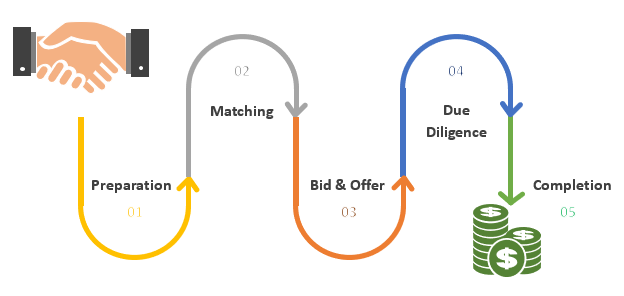Mergers and Acquisitions (M&A) – How to Buy and Sell a Business
Looking to buy a business for expansion?
Or looking for an exit plan or to monetize your non-core asset via selling the business or divestment?
Or figuring out a succession planning strategy, be it a 100% sale or management to buy out the existing shareholders or other ways?
These are all different forms of mergers and acquisitions, or M&A in short, and can be an overwhelming experience for a lot of business owners as it involves a lot of effort, time and energy. Here we present a simple step by step guide to give you an idea of what is covered in the M&A process, be it if business owners are looking to buy or acquire another business, or if you want to sell or divest your current business at hand.
Typically, a business M&A transaction for the sale of a business involves the following 5-stage process:

Stage 1: Preparation
This is an extensive process of preparing the business to be ready for the M&A process. The preparation may involve the following:
- Discussion and deciding on the M&A strategy
- Valuation of the business
- Vendor due diligence
- Drafting up a teaser and an information memorandum
Each of the steps involves substantial work behind it to ensure that the M&A process achieves your goal and to get the best result of maximizing shareholders’ benefit.
Stage 2: Matching
Once the preparation is ready, it is time to go out to look for suitable buyers of the business. In this stage, it is important to understand who you would like to show your business to as business sensitive information will be shared with the parties contacted. The potential buyers or acquirers can be generally categorized into two types: strategic and financial.
Strategic players refer to other similar businesses, often direct competitors or companies operating in the same industry, such that the M&A would fit in nicely with the buyer’s core business and achieve synergies. As strategic players are more sensitive in nature, it is important to ensure only quality candidates (i.e. financially feasible to do any acquisition) are being shortlisted.
Financial players are institutional buyers, such as private equity firms, that are looking to own, but not directly operate the acquisition target, with the intention to exit at a profit at a later date.
Once the list is finalized, the teaser can be sent out to each of the potential buyers or acquirers to gauge their interest first.
Stage 3: Bid & Offer
When the potential buyer or acquirer has indicated interest to explore further, then the information memorandum will be shared out. At this stage, there will various high-level questions and answers (Q&A) going back and forth. There will also be a meeting scheduled between the buyer and seller – dubbed the Management Meet.
The potential buyer or acquirer will make their own assessment, performing a preliminary assessment and high-level due diligence based on the information provided (e.g. competitor analysis, market research, projections, valuation, etc). Once they are ready, they will give an offer in the form of a non-binding term sheet that includes the pricing offered and critical terms and conditions, which will be subject to any subsequent changes based on the results from the due diligence process.
Stage 4: Due Diligence
If business owners are satisfied with the terms in the term sheet provided, then you will open up to the potential buyer or acquirer to perform a detailed due diligence on your company. It is important to note that at this stage to set a timeline for the due diligence to conclude and provide you with a final binding offer. Typically, this could range anywhere from 30 days to 90 days.
The due diligence involved are typically:
- Financial due diligence (check the financial records of the business)
- Tax due diligence (check the tax status and any outstanding liabilities)
- Legal due diligence (check all legal documents)
- Commercial due diligence (check the viability of the operations of the business)
As part of the preparation stage, if the vendor due diligence is done, then there will not be any surprises during this stage. However, this stage is potentially a lot of areas where deal breakers can appear.
If there are no major issues in the due diligence, then the potential buyer and acquirer will give the seller of the business with a final binding offer.
Stage 5: Completion
Once both buyer and seller have agreed to the terms in the final binding term sheet, this stage entails the completion of the deal by drafting the appropriate legal documents (e.g. sales and purchase agreement) and the transfer of shares and purchase consideration (money).
At this stage it is important to engage a legal advisor or lawyer of relevant field to draft an agreement.
That covers the entire M&A or buy and sell process, which is as relevant for the buyer as it is for the seller. Whilst this is a simple guide, the process itself is by no means a simple process and is very important to make sure that it is done in a structured and controlled manner to ensure that the buyer and seller can achieve the objective of the M&A.
Timeline
In a typical M&A process, the timeline will take anywhere from 6 months to 2 years to complete, depending on the complexity of the deal.
Therefore, it is important to make sure that business owners start the planning early for any acquisition or divestment.
Thinking about M&A now?
We truly believe that business owners should focus on building the value of the business.
For all your mergers and acquisitions needs, our experienced corporate advisory department can assist you and ensure that the process gets as smooth as it can be. Reach out to us and we will be able to consider your case to buy and/or sell businesses and advise you where required.
Just like you who specialize in building your own business, we specialize in the M&A business and let us help you through this process so that it’s a win-win-win for all parties involved!
Return to Corporate Advisory Page
